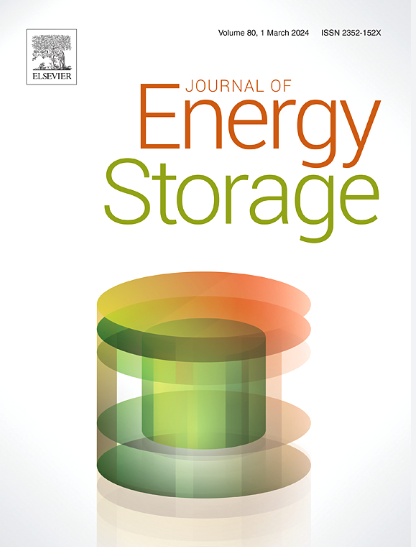电池储能如何影响电网拥堵——不同电池控制策略的权衡评估
IF 8.9
2区 工程技术
Q1 ENERGY & FUELS
引用次数: 0
摘要
为了减少温室气体排放,世界各国都在推行电气化政策。在居民区,电气化将增加电力供应和需求,预计这将以比电网加强速度更快的速度增加电网拥堵。电池储能(BES)具有减少电网拥塞和推迟电网加固的潜力,从而支持能源转型。但是,BES同样可能加剧电网拥堵。这就引出了一个问题:考虑到电池性能和电池电网的影响,不同的电池控制策略之间的权衡是什么?本文利用电池储能评估方法(BESEM)解决了这一问题,该方法将电池储能模型与电网模型连接起来,以模拟这两个系统之间的相互作用。本文将BESEM应用于实例研究,比较了不同BESEM控制策略的相对效果。本案例研究的结果表明,如果电池被被动控制(即限制电池功率)或主动控制(即覆盖正常的电池操作),则电池可以减少电网拥堵。研究发现,使用电池来减少拥堵会减少电池给电池所有者带来的主要好处,但会增加次要好处。此外,在某些情况下,被动电池控制在减少电网拥堵方面几乎与主动电池控制一样有效。这些发现表明,不同电池控制策略之间的权衡并不总是显而易见的,应该使用像BESEM这样的方法进行评估。本文章由计算机程序翻译,如有差异,请以英文原文为准。

How battery energy storage impacts grid congestion – An evaluation of the trade-offs between different battery control strategies
To reduce greenhouse gas emissions, countries around the world are pursuing electrification policies. In residential areas, electrification will increase electricity supply and demand, which is expected to increase grid congestion at a faster rate than grids can be reinforced. Battery energy storage (BES) has the potential to reduce grid congestion and defer grid reinforcement, thus supporting the energy transition. But, BES could equally exacerbate grid congestion. This leads to the question: What are the trade-offs between different battery control strategies, considering battery performance and battery grid impacts? This paper addresses this question using the battery energy storage evaluation method (BESEM), which interlinks a BES model with an electricity grid model to simulate the interactions between these two systems. In this paper, the BESEM is applied to a case study, wherein the relative effects of different BES control strategies are compared. The results from this case study indicate that batteries can reduce grid congestion if they are passively controlled (i.e., constraining battery power) or actively controlled (i.e., overriding normal battery operations). Using batteries to reduce congestion was found to reduce the primary benefits provided by the batteries to the battery owners, but could increase secondary benefits. Further, passive battery controls were found to be nearly as effective as active battery controls at reducing grid congestion in certain situations. These findings indicate that the trade-offs between different battery control strategies are not always obvious, and should be evaluated using a method like the BESEM.
求助全文
通过发布文献求助,成功后即可免费获取论文全文。
去求助
来源期刊

Journal of energy storage
Energy-Renewable Energy, Sustainability and the Environment
CiteScore
11.80
自引率
24.50%
发文量
2262
审稿时长
69 days
期刊介绍:
Journal of energy storage focusses on all aspects of energy storage, in particular systems integration, electric grid integration, modelling and analysis, novel energy storage technologies, sizing and management strategies, business models for operation of storage systems and energy storage developments worldwide.
 求助内容:
求助内容: 应助结果提醒方式:
应助结果提醒方式:


